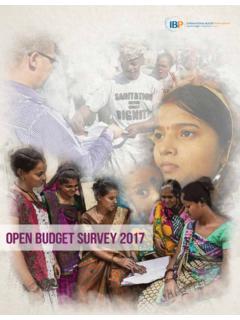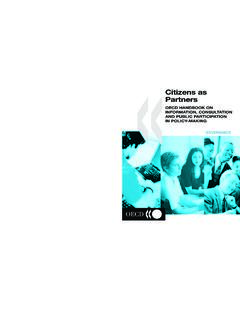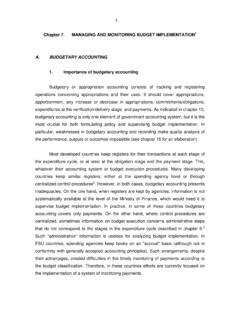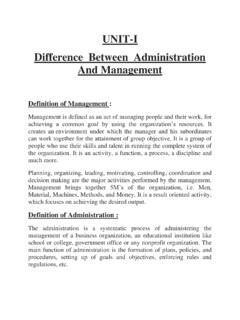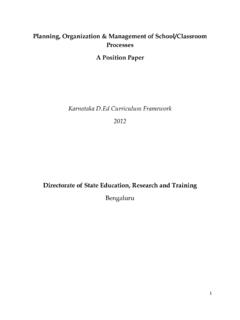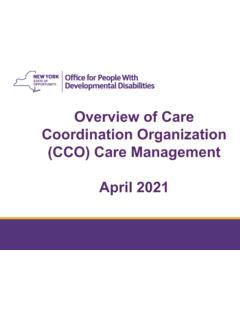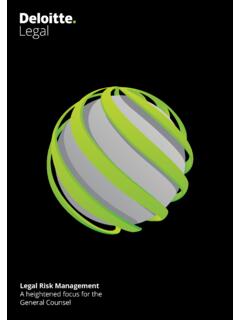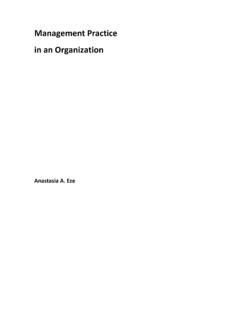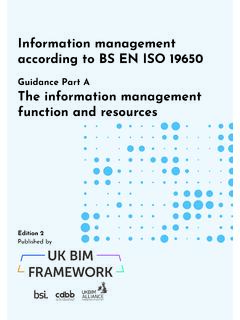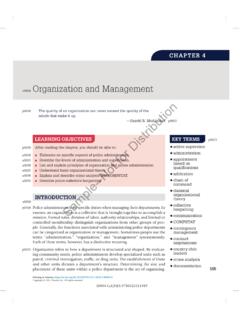Transcription of Chapter 8. CASH MANAGEMENT AND THE TREASURY …
1 Chapter MANAGEMENT AND THE TREASURY TREASURY FUNCTION Governments need to ensure both efficient implementation of their budgets andgood MANAGEMENT of their financial resources. Spending agencies must be providedwith the funds needed to implement the budget in a timely manner, and the cost ofgovernment borrowing must be minimized. Sound MANAGEMENT of financial assets andliabilities is also MANAGEMENT within the government includes various activities:formulation of fiscal policy; budget preparation; budget execution; MANAGEMENT offinancial operations; accounting; and auditing and evaluation. Within this broadfinancial MANAGEMENT function, the TREASURY function is to achieve the set of specificobjectives mentioned above. It covers the following activities:2 Cash MANAGEMENT ; MANAGEMENT of government bank accounts; Financial planning and forecasting of cash flows; Public debt MANAGEMENT ; Administration of foreign grants and counterpart funds from international aid; Financial assets MANAGEMENT .
2 1 The government s strategy to manage its moneys to maximize financial return s a critical part of overallcash MANAGEMENT . The accent of this Chapter , however, is on control of cash flows and on the efficiencyof payments arrangements, in keeping with the expenditure focus of this entire Cf, Teresa Ter-Minassian, Pedro P. Parente, and Pedro Martinez-Mendez, "Setting up a TREASURY ineconomies in transition," IMF, carry out these activities, organizational arrangements and distribution ofresponsibilities vary considerably according to countries. In some countries, theTreasury Department focuses only on cash and debt MANAGEMENT functions (which arereviewed in this section). In a few countries, debt MANAGEMENT is performed by anautonomous agency. In other countries, the TREASURY Department performs budgetexecution controls (which are reviewed in Chapter 6) and/or accounting and budgetexecution reporting activities (which are reviewed in chapters 10 and 11).
3 MANAGEMENT3 Cash MANAGEMENT has the following purposes: controlling spending in theaggregate, implementing the budget efficiently, minimizing of the cost of governmentborrowing, and maximizing the opportunity cost of resources (the last two purposesyielding interest). Control of cash is a key element in macroeconomic and budgetmanagement. However, as emphasized in Chapter 5, it must be complemented by anadequate system for managing commitment. For efficient budget implementation, it isnecessary to ensure that claims will be paid according to the contract terms and thatrevenues are collected on time. It is necessary to minimize transaction costs; and toborrow at the lowest interest rate or to generate additional cash by investing inrevenue-yielding paper. It is also necessary to avoid paying in advance and to trackaccurately the dates on which payments are developing countries, governments often do not pay attention to issuesrelated to cash MANAGEMENT .
4 Budget execution procedures and the MANAGEMENT ofcash flows focus on compliance issues, while daily cash needs in are met at low costby the Central Bank. Spending units are not concerned with borrowing costs since theirinterests are already taken account in the budget prepared by the Ministry of , the costs of borrowing, the fact that the credit granted to thegovernment by the banking system is a key macroeconomic target and a performance 3 The relationship between the TREASURY and the Central Bank in this and other respects is brieflydiscussed in in IMF-supported financial programs, and the increasing separation betweenthe activities of the Central Bank and the government budget make cash managementmore important. Performance concerns have also had an impact on cash managementand some countries have implemented reforms to make spending agencies moreresponsible for cash, while maintaining instruments to ensure fiscal 26 Cash MANAGEMENT in the PhilippinesUntil 1985, cash authorizations were issued to government agencies eachquarter through the release of cash disbursement ceilings (CDCs) which specify themaximum amounts that the agencies can withdraw from the Bureau of the TREASURY (BTr) to pay for their obligations.
5 Even with the creation of a New Disbursement Systemin 1986 the CDC system, the tendency for agencies to issue checks and Treasurywarrants in excess of the amounts provided May 1990, the Synchronized Planning-Programming-Budgeting System(SPPBS) was introduced to improve coordination among the budget, planning andrevenue agencies and ensure the consistency of budget plans with development goalsand available funds. In the following year, the Department of Budget and MANAGEMENT (DBM) and the Department of Finance (DOF) initiated the creation of an Inter-AgencyCommittee on Cash Programming composed of representatives from the DBM, DOF,BTr, and the Central Bank. Regular meetings were held to assess the fiscalperformance of the national government for the previous month and to discussprospects for the succeeding months. The Committee determined the disbursementceiling on which the issuance of Notices of Cash Allocation (NCAs) was SPPBS did nothing to resolve the situation, and problems with cash floatand timeliness of cash releases continued.
6 Accordingly, in 1992, the ModifiedDisbursement System was established to provide for closer coordination between DBMand DOF in releasing funds, based on shorter-term calculations of cash , to optimize their use of cash in their priority programs, implemented cashconservation the Modified Disbursement System, the DBM continued to allocate fundsappropriated under the General Appropriations Act. The DOF made the correspondingarrangements with the servicing banks, deposited the minimum funding requirementsfor each government entity, and replenished these deposits regularly. The depositswere maintained by the Treasurer of the Philippines and interest earned accrued to theGeneral the event that the estimated cash balance of the government reached a levelwhere budget cuts could be avoided, the DBM implemented proportionate across-the- 4 The 1997 annual report of the Western Australia Audit Office, for instance, shows the savings madethrough the reform of payment techniques and accounting procedures in the main roads agency of thegovernment of Western reductions in the budget.
7 Government agencies, however, continued todetermine disbursement priorities, subject only to the prior payment of personalservices and mandatory expedite and standardize the release of funds across agencies in line withspecific policy initiatives of the government, the Simplified Fund Release System(SFRS) was implemented in 1995. It standardizes releases across governmentagencies that are similarly situated. It allows flexibility in the use of funds within limitsprescribed by law and simplifies the process, thereby reducing paperwork andfacilitating the monitoring of allotment : Darlene Casiano, Department of Budget of MANAGEMENT , January of cash It is necessary to minimize the interval between the time when cash is receivedand the time it is available for carrying out expenditure programs. Collected revenuesneed to be processed promptly and made available for use.
8 When tax collection isdone by the tax administration offices (or by TREASURY offices) the administrativeorganization of these offices may have to be reviewed and their banks by virtue of the banking sector infrastructure are often able tocollect revenues more efficiently than tax offices, which should therefore focus insteadon tracking taxpayers. When revenues are collected by commercial banks,arrangements must be defined to foster competition and ensure prompt transfer ofcollected revenues to government accounts. Systems of bank remuneration throughfloat, which consists of authorizing the banks to keep the revenues collected for a fewdays, present inconveniences. Stringent rules to ensure prompt transfers must beestablished. Moreover, bank remuneration through fees is more transparent andpromotes competitive bidding. An appropriate system of penalties for taxpayers is alsoan important element in avoiding delays in revenue collection.
9 5 See Herma R. de Zoysa, Cash MANAGEMENT , in Premchand (1990). For cash MANAGEMENT , the control of cash outflows, which is directly related toorganizational arrangements for budget execution, can pose more difficulties than thecontrol of cash inflows. However, issues related to cash MANAGEMENT should not beconfused with issues related to the distribution of responsibilities for accounting controland administration of the payment system. The major purpose of controlling cashoutflows is to ensure that there will be enough cash until the date payments are dueand to minimize the costs of transactions, while keeping cash outflows compatible withcash inflows and fiscal constraints. The first condition for ensuring that cash outflows fit fiscal constraints is goodbudget preparation and budget implementation covering both cash and , during budget implementation, cash outflows must also be regulated throughcash plans to smooth cash techniques Payment methods affect the transaction costs of cash outflows.
10 Depending onthe banking infrastructure and the nature of expenditures, various payment methodsmay be considered (check, cash, electronic transfer, debit card, etc.).6 Modern methodsof payment, for example, payment through electronic transfers instead of throughchecks or cash, allow the government to plan its cash flow more accurately, expeditepayments, and simplify administrative and accounting procedures. However, whetherone mode of payment is preferable to another depends on many factors, such as thedegree of economic development of the country, the banking network, the status ofcomputerization. For payments within government (when an agency provides servicesto another agency), a number of countries use nonpayable checks, while others makebook adjustments. Using nonpayable checks has the advantage of avoiding delays in 6 Instruments for payment are presented in Premchand, Effective government accounting, IMF, 1995, page25 (table 1) and page 27 (table 3).

